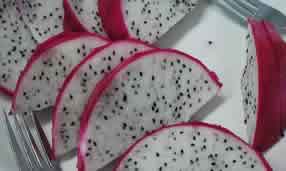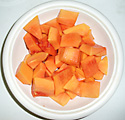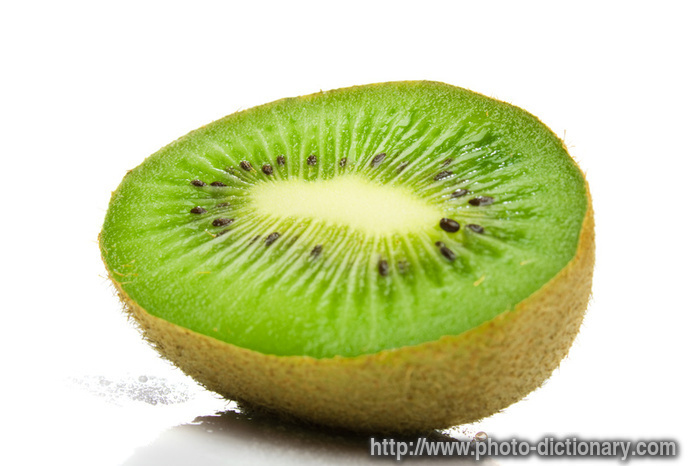Orange
fruit nutrition facts
Delicious
and juicy
orange fruit contains an impressive list of
essential nutrients, vitamins, minerals for normal growth and
development and overall well-being.
Botanically; orange is the
citrus fruit belonging to the family of
Rutaceae of the
genus; Citrus (which also includes pomelo,
tangerine
(mandarin orange)
and
grapefruit).
Scientifically the fruit is named as
"Citrus
sinensis".
Orange is a tropical to
semitropical, evergreen, small flowering tree
growing to about 5 to 8 m tall and bears seasonal fruits that measure
about 3 inches in diameter and weighs about 100-150 g. Oranges are
classified into two general categories,
sweet and
bitter, with the
former being the type most commonly consumed. Popular varieties of the
sweet orange include
Valencia,
Navel,
Persian variety, and
blood
orange.
Tangerines are related varieties of oranges
distinguished by loose, easily peeled shin (pericarp) and sweet juicy
flesh (arils). They are also known as
mandarin oranges in
Europe and
satsumas
in Japan. Just as oranges, these too belong to the
Rutaceae (citrus
Family) and known scientifically as
Citrus
reticulata.
Fruits belonging to citrus
group are described as
“hesperidium”, (A hesperidium is a scientific term to describe the
fruit structure belonging to citrus group. In fact, the fruit is a
modified berry
with tough, leathery rind. Oranage
peel
contains many volatile
oil glands in pits. Interior flesh is composed of
segments,
called
carpels,
made up of numerous fluid-filled vesicles that are
actually specialized hair cells).
Health
benefits of oranges
-
Nutrients in oranges are
plentiful and diverse.
The fruit is low in calories, contains no saturated fats or
cholesterol, but is rich in dietary fiber, pectin,
which is
very effective in persons with excess body weight. Pectin, by its
action as bulk laxative, helps to protect the mucous membrane of the
colon by decreasing its exposure time to toxic substances as well as by
binding to cancer causing chemicals in the colon. Pectin has also been
shown to reduce blood cholesterol levels by decreasing its
re-absorption in the colon by binding to bile acids
in the
colon.
-
Oranges, like other citrus
fruits, is an
excellent source of vitamin
C (provides about 60% of DRI); Vitamin C is a powerful
natural antioxidant. Consumption of foods rich in vitamin C helps body
develop resistance against infectious agents and scavenge
harmful, pro-inflammatory free radicals from the blood.
-
Orange fruit contains a
variety of
phytochemicals. Hesperetin
and Narigenin
are flavonoids found in citrus fruits. Naringenin is found to have a
bio-active effect on human health as antioxidant, free radical
scavenger, anti-inflammatory, and immune system modulator. This
substance has also been shown to reduce oxidant injury to DNA in vitro
studies.
-
Oranges also contain very
good levels of vitamin A,
and
other flavonoid antioxidants such as alpha and beta-carotenes, beta-cryptoxanthin,
zea-xanthin
and lutein.
These compounds are known to have antioxidant properties. Vitamin A
is also required for maintaining healthy mucus membranes and skin and
is essential for vision. Consumption of natural fruits rich in
flavonoids helps body to protect from lung and oral cavity cancers.
-
It is also a very good
source of B-complex
vitamins such as thiamin, pyridoxine, and folates. These vitamins are
essential in the sense that body requires them from external sources to
replenish.
-
Orange fruit also contains
a very good amount
of minerals like potassium and calcium. Potassium is an important
component of cell and body fluids that helps control heart rate and
blood
pressure through countering sodium actions.
Citrus fruits, as such, have long
been valued for their wholesome nutritious and antioxidant properties.
It is scientifically established that citrus fruits, especially
oranges, by virtue of their richness in vitamins and minerals,
have many proven health benefits. Moreover, it is now beginning to be
appreciated that the other biologically active, non-nutrient compounds
found in citrus fruits such as
phyto-chemical
antioxidants,
soluble
and
insoluble dietary
fiber have been found to be helpful in reduction in the
risk for cancers, many chronic diseases like arthritis, and from
obesity and coronary heart diseases.
Selection
and storage
Orange fruit
season begins from October and lasts until February. Mature fruits are
usually harvested from the tree using machines, and thus may sustain
minor, superficial injuries. Such small abrasions however, on the fruit
surfaces usually do not influence the quality of the fruit.
In the store,
buy fresh fruits that feature firmness, yet yield to gentle pressure
but recoils immediately. Fresh oranges have
bright color, devoid of any wrinkles on the skin, should feel heavy for
their size, and emanate sweet aroma. Avoid overtly soften fruits with
spots and mold as they tend to perish early.
Oranges can be
kept at room temperature for a week or so and but keep
well for up to two weeks in the fruit/vegetable compartment of the home
refrigerator. Keep them loose in the fruit container and place in cool
area away from excessive moisture as they tend to get mold infection
early. Store freshly squeezed orange juice inside the freezer
compartment for later use. Store dried orange zest in a cool, dry place
in an airtight glass container away from moisture.
Preparation
and serving tips
Orange fruit
can be carried to
any place without
much cumbersome. Fresh oranges can be eaten at anytime, anywhere; just
wash
them under running water to remove surface dirt and any pesticide
residues, peel the skin, and enjoy!
Remove skin
after scoring
superficially on the skin with your fingers or using a knife. Remove
rind and fibers and gently peel off membranes and seeds. They are
usually eaten this way. They can also eaten by slicing the fruit
horizontally into two halves and scooping out sections of the halves
with a spoon.
Orange
fruit juice is also as much popular as raw ones; however, use raw
fruits instead of juice for the maximum benefit of antioxidants. Fiber
content in the fruit is also lessened to a great degree in the juice.
If you wish to go for fresh orange juice, then prepare it yourself at
home instead of commercial drinks that may contain preservatives and
artificial colorants. Bring the fruit to room temperature if kept in
the refrigerator.
The outermost
part of the rind grated using zester to produce orange
zest, which also have many culinary values for its flavor rich oil
glands.

Here are some Serving tips:
-
Orange fruit sections are a great addition to
green and fruit salads.
-
Orange fruit juice can be a re-freshening
intra-day drink.
-
The fruit is also used in the preparation of
desserts, jams, and jellies.
-
Orange
zest (peel) is also used in preparation
of popular dishes for its rich flavor.
-
Dried orange blossoms and leaves are
used as herbal tea.
Safety
profile
Insecticide sprays are widely
applied over orange crops. Therefore, it
is recommended to wash the fruits in cold running water before use.
Organic orange fruits are devoid of these chemicals and are best suited
for
zest preparation.












 Incise
lengthwise deeply till the hard seed felt and then remove the seed.
Skin may be peeled off using paring knife as in apples. However, its
peel not only provides good
fiber content but also contains some health benefiting anti-oxidant
pigments.
Therefore, just wash the fruit and enjoy without discarding the skin.
They can also be baked or stewed.
Incise
lengthwise deeply till the hard seed felt and then remove the seed.
Skin may be peeled off using paring knife as in apples. However, its
peel not only provides good
fiber content but also contains some health benefiting anti-oxidant
pigments.
Therefore, just wash the fruit and enjoy without discarding the skin.
They can also be baked or stewed.










